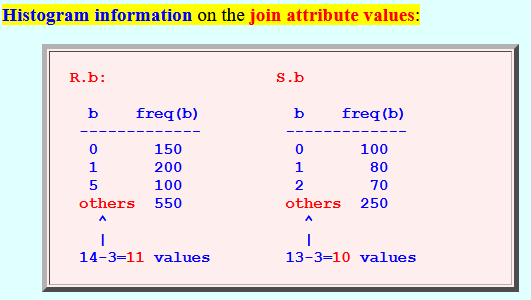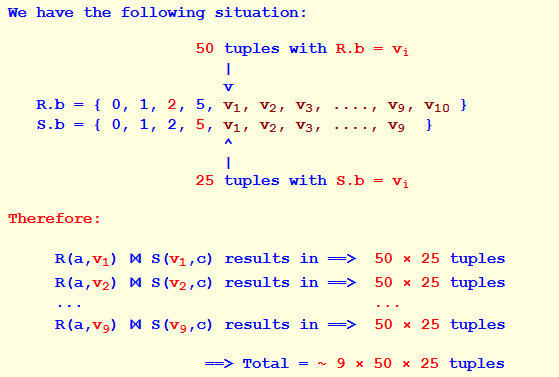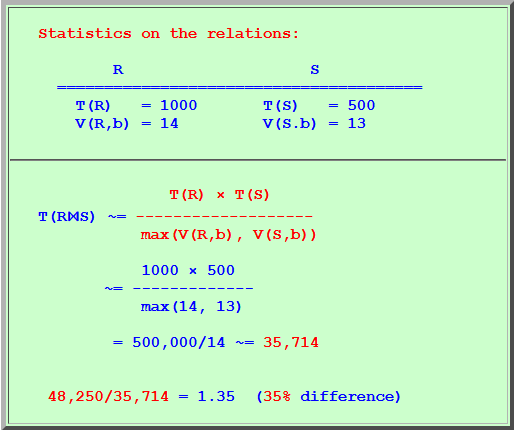Slideshow:
- Statistical data on the
input relations:
- Relation level
statistics:
R = R(a,b) S = S(b,c) Statistics on the relations: R S ======================================= T(R) = 1000 T(S) = 500 V(R,b) = 14 V(S,b) = 13
-
Histogram information on
the join attribute values:
R.b: S.b b freq(b) b freq(b) ------------- ------------- 0 150 0 100 1 200 1 80 5 100 2 70 others 550 others 250 ^ ^ | | 14-3=11 values 13-3=10 valuesUniformity assumption:
R.b: 550 tuples has 11 different values <==> 50 tuples per attribute value
S.b: 250 tuples has 10 different values <==> 25 tuples per attribute value
- Relation level
statistics:
- Problem:
- Give an estimate of the size of R(a,b) ⋈ S(b,c)
- Worked out
example:
- Input:
V(R,b) = 14 T(R) = 1000 V(S,b0 = 13 T(S) = 500 R.b = 0(150) 1(200) 5(100) + 11 other values(50 each) S.b = 0(100) 1(80) 2(70) + 10 other values(25 each)
- Applying the
containment of
value sets
assumption, we have:
V(R,b) = 14 T(R) = 1000 V(S,b0 = 13 T(S) = 500 R.b = 0(150) 1(200) 2(50) 5(100) + 10 other values(50 each) S.b = 0(100) 1(80) 2(70) 5(25) + 9 other values(25 each)
Therefore the join result of the value b = 0, 1, 2, 5 are:
V(R,b) = 14 T(R) = 1000 V(S,b0 = 13 T(S) = 500 R.b = 0(150) 1(200) 2(50) 5(100) + 10 other values(50 each) S.b = 0(100) 1(80) 2(70) 5(25) + 9 other values(25 each) | | | | V V V V 15,000 16,000 3,500 2,500 tuples (=150×100)
- Computing the
join result for
the "other" values:
We continue to make the containment of value set assumption Because: V(S,b) ≤ V(R,b) ===> all values of S.b are assumed to be in R.b
Therefore: R.b = { 0, 1, 2, 5, + 10 other values (50 tuples each) } S.b = { 0, 1, 2, 5, + 9 other values (25 tuples each) } We have the following situation: 50 tuples with R.b = vi | v R.b = { 0, 1, 2, 5, v1, v2, v3, ...., v9, v10 } S.b = { 0, 1, 2, 5, v1, v2, v3, ...., v9 } ^ | 25 tuples with S.b = vi Therefore: R(a,v1) ⋈ S(v1,c) results in ==> 50 × 25 tuples R(a,v2) ⋈ S(v2,c) results in ==> 50 × 25 tuples ... ... R(a,v9) ⋈ S(v9,c) results in ==> 50 × 25 tuples ==> Total = ~ 9 × 50 × 25 tuples
- Therefore:
T(R⋈S) ~= 15,000 + 16,000 + 2,500 + 3,500 + 9×50×25 ~= 48,250 tuples
- Input:
- Compare: estimate
without using
histogram information
Statistics on the relations: R S ======================================= T(R) = 1000 T(S) = 500 V(R,b) = 14 V(S.b) = 13
T(R) × T(S) T(R⋈S) ~= ------------------- max(V(R,b), V(S,b)) 1000 × 500 ~= ------------- max(14, 13) = 500,000/14 ~= 35,714 48,250/35,714 = 1.35 (35% difference)









